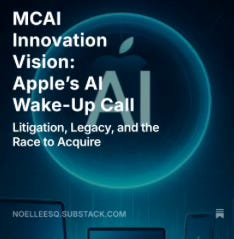MCAI Innovation Vision: Apple’s AI Wake-Up Call
Litigation, Legacy, and the Race to Acquire
I. Executive Summary
The June 2025 shareholder lawsuit marks a turning point for Apple. No longer a quiet laggard in AI, Apple now faces legal, reputational, and strategic pressure to transform. The litigation is a definitive signal: Apple must supercharge its AI capabilities, not through incrementalism but by decisive acquisition. This report outlines the core challenge and identifies urgent acquisition paths to restore coherence and innovation.
II. Lawsuit as Signal: Shareholder Suit on AI Disclosure Failures
Apple's reckoning with artificial intelligence is now legal. The lawsuit alleges Apple misled investors about its generative AI capabilities, roadmap, and readiness. This breakdown in disclosure is more than a technical misstep—it undermines the very trust Apple has built its brand on. It’s also a proxy for deeper structural and cultural gaps in Apple’s AI strategy.
III. Why Apple Must Acquire to Lead
While Apple could theoretically respond to the shareholder lawsuit through improved disclosures or internal development acceleration, these steps alone are insufficient. The nature of the lawsuit—focused on omissions and misleading representations—has eroded investor confidence in the credibility of Apple’s current AI roadmap. To restore trust swiftly and substantively, Apple must demonstrate that it has closed both the capability and transparency gaps. Strategic acquisitions offer a concrete, auditable signal to the market that Apple is not merely reacting, but reorienting.
Apple has made visible investments in on-device AI, notably its Private Cloud Compute infrastructure and the integration of neural engines into its custom silicon. These represent real technical strengths, particularly around privacy and latency. However, Apple’s strategy remains siloed—focused more on containment than on building an expansive AI ecosystem. The shareholder litigation underscores that technical efforts alone are insufficient; Apple must also signal narrative clarity and market ambition through strategic acquisitions.
Two recent foresight simulations (SIMs)—“Apple and the Illusion of Thinking” and “MCAI to Power AI Companions”—highlight the deeper structural factors that explain Apple's hesitation. The first argues that Apple's instinct for control and aesthetic polish has hindered its capacity for recursive, probabilistic reasoning—essential for AI leadership. The second envisions what a future-facing assistant might look like when built on foresight, trust, and legacy modeling—areas Apple has yet to fully articulate. These SIMs reinforce the view that Apple’s challenge isn’t just technical—it’s cognitive and cultural.
A. Perplexity AI
Conversational retrieval and clean UX fit seamlessly into Apple’s design principles.
Could rapidly enhance Siri and Safari’s utility as first-party knowledge assistants.
Integrates with Spotlight, Messages, and Maps to create a coherent AI layer across devices.
B. Mistral or Anthropic
Provide foundation model and fine-tuning infrastructure Apple currently lacks.
Enable Apple to train privacy-preserving large language models on-device and in iCloud.
Could accelerate developer platform enhancements (e.g., new API layers for Vision Pro and macOS).
C. MindCast AI (MCAI)
Offers simulation-based foresight tools that could support Apple’s long-term planning, particularly in health, developer support, and trust infrastructure.
Its architectural strengths lie in modeling user trust and cognitive workflows—potentially valuable in Apple Health and educational tools.
If culturally aligned, MCAI could serve as a research asset to prototype Apple’s own simulation frameworks rather than a consumer-facing layer.
IV. Alternative Strategies: Partnerships and Licensing
While acquisitions offer Apple a bold path to restore trust, they are not the only option. Strategic partnerships or licensing agreements could enable Apple to integrate cutting-edge AI without the friction of full absorption. For example, a deep partnership with Perplexity or licensing a model from Anthropic would allow Apple to retain control over product integration while gaining near-term capabilities. However, these approaches may be perceived as stopgaps and lack the long-term signal strength needed to fully reassure investors.
V. Competitive and Integration Considerations
Any acquisition must balance speed with cultural fit. Perplexity offers rapid deployment potential but may resist full integration into Apple’s controlled UX philosophy. Anthropic or Mistral could raise cost and regulatory concerns, especially given alignment with existing cloud giants. Meanwhile, competitors like Google (Gemini) and Microsoft (OpenAI) have already defined their AI stack—and their pace of iteration is accelerating.
VI. Strategic Deployment: How Acquisitions Translate to Products
Once acquired, these capabilities must be deployed across the Apple ecosystem:
Siri becomes context-aware, conversational, and predictive—not just reactive.
Safari turns into a trusted retrieval and learning interface.
Apple Health integrates foresight and simulation for chronic care and mental wellness.
Vision Pro gains intelligent scene prediction and conversational overlay agents.
App Store offers developers new APIs for training private, on-device AI assistants.
Apple’s AI future must be trust-first, privacy-rich, and architecturally open enough to invite developer and user alignment.
VII. Conclusion: Litigation as an Inflection Point
The lawsuit is not just legal friction—it’s a final warning. Apple must translate its culture of design coherence into a culture of AI foresight. Strategic acquisition is not optional—it is the clearest path to narrative and technological relevance. The next 90 days are decisive.





